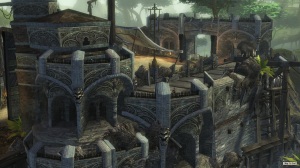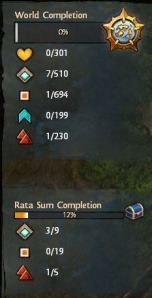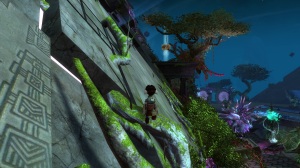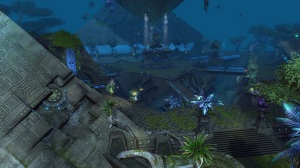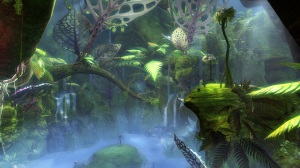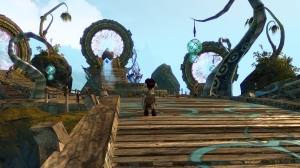Archive
Guild Wars 2: When a map is more than a map
Since the first beta weekend event, I’ve discovered plenty of reasons to love Guild Wars 2. But strangely enough, it’s not the combat or the personal story that has me the most excited after the last stress test. It’s not even world versus world combat. Of all things, it’s the map of Tyria that has my attention. I’m an explorer when it comes to virtual worlds; I like to find their edges. For people like me, the Guild Wars 2 map is more than just a map; it’s a scavenger hunt and a game unto itself.
Each area in Guild Wars 2 has a list of objectives for players to find on every map. Certainly, many of these objectives by themselves are nothing new. Plenty of games award players some kind of recognition for visiting points on a map. But ArenaNet seems to have figured out that overlaying several kinds of objectives with very different reward mechanisms creates a map that demands completion from just about any player. Just as the game’s in-game scouts point out nearby objectives for wayward players, the overall map of Tyria with its tantalizing completion bars encourages players of all kind to get out into the world and explore.
- Hearts of Renown track NPCs you help across the region. Players interested in story or simple level advancement should pursue these to get extra experience not only from the hearts, but the dynamic events they are bound to encounter on the way.
- Waypoints grant every player quick travel capability to point on the map. Having access to these not only improves player quality of life, but makes it easier for players to respond to and participate in rare dynamic events when they pop up.
- Points of Interest may not seem like much, but they offer experience when finding them and any completionist is going to want to hit them all.
- Skill Challenges offer players unique ways to earn skill points outside of normal leveling. Often tucked in out of the way areas, they are a quick way for any player to unlock some utility skills early and gain an edge.
- Vistas are accessible through jumping puzzles. Upon reaching the points, players are rewarded with panoramic cinematics of some of Tyria’s best sites.
- Completing an area awards players with a huge boost of experience as well as a chest with appropriate level gear. These alone make completing a zone worth the extra effort if a player is racing to max level.
Of the objectives described above, vistas are the ones I’ve come to love the most. The jumping puzzles are wonderful diversions from traditional player versus environment game play. They turn the terrain into an opponent. Reaching the vista is sometimes easy with obvious staircases with simple jumps. Sometimes it’s less than intuitive like climbing vines along a wall. Either way, getting the prize is always satisfying. I have never been what you can call a graphics hound when it comes to games, but the cinematic rewards have already created several different backgrounds for my computer and are more than enough reason to seek them out.
At the end of Beta Weekend 3 and the last stress test, there were over 1900 objectives for players to search for in game. This number will only go up as ArenaNet releases new parts of the map to explore in future content updates. Unlike in other games where you can quickly out level an area, minimizing the fun of exploration by taking away the danger, Guild War 2’s dynamic level adjustment keeps every objective relevant for players until each and every one is found. Newly released MMOs are often criticized on release for lacking content, but with such a robust system already tied into the world map, ArenaNet looks well poised to avoid that critique from explorers.
There are two reasons I play MMOs: the experience of playing with others (competitively and cooperatively) and to test the limits and depth of the virtual worlds they provide. The first MMO I played for more than a few months was Asheron’s Call. What got me hooked on that game over other more popular options at the time were the hidden places to explore on the map. I’ve yet to find another MMO with a world quite so robust in terms of exploration potential. With the Guild Wars 2 release date fast approaching, I should soon be able to revise that statement.
Droids Gone Wild
 This week I’m going to spend some time talking about my impressions trying out Star Wars: The Old Republic. As the breakout MMO for BioWare, the game had a lot of hype to live up to given the company’s past performance with several blockbuster franchises such as Mass Effect and Dragon Age. Overall, I found the leveling experience in the Old Republic to be worth the money I shelled out on the game – mostly due to BioWare’s ability to get a player involved in a great story. But I do have some reservations about the game’s ability to draw in long term loyalty from fans. I expect that being tied to the Star Wars franchise itself will keep the game alive for some time, but without streamlined multi-player features, I doubt that I’ll be playing the Old Republic over the long haul. For those with attention issues, I’ve captured my key thoughts below. Everyone else, feel free to hit the text wall at hyper speed.
This week I’m going to spend some time talking about my impressions trying out Star Wars: The Old Republic. As the breakout MMO for BioWare, the game had a lot of hype to live up to given the company’s past performance with several blockbuster franchises such as Mass Effect and Dragon Age. Overall, I found the leveling experience in the Old Republic to be worth the money I shelled out on the game – mostly due to BioWare’s ability to get a player involved in a great story. But I do have some reservations about the game’s ability to draw in long term loyalty from fans. I expect that being tied to the Star Wars franchise itself will keep the game alive for some time, but without streamlined multi-player features, I doubt that I’ll be playing the Old Republic over the long haul. For those with attention issues, I’ve captured my key thoughts below. Everyone else, feel free to hit the text wall at hyper speed.
SWTOR…
… plays like a single player game despite being massively multi-player.
… feels like you’re in a Star Wars movie, to include cross-planet road trips.
… offers some unique gameplay mechanics, despite replicating a lot of WoW’s game design.
… rewards players for their choices, but not necessarily the way you want.
… does a poor job of facilitating group content, a major problem for a multi-player game.
… looks to have a development team who appears to be willing to tackle the game’s weak spots.
Disclaimer: When I started writing this post, I tried not to compare the Old Republic to World of Warcraft because so many others have done it. However, many of the similarities (like the way player skills are grouped) were so obvious that it was like BioWare wanted the familiarity. I’m relatively forgiving of those decisions because who wouldn’t want to copy some of the success of a game with over 10 million subscribers? Where possible, I’ve tried to highlight some of the game’s unique features, many of which do not get much press despite providing substantial portions of the gameplay.
A long time ago, in a galaxy far, far away…
The Old Republic continues BioWare’s track record of emphasizing player-driven story interwoven with gameplay. I find the Star Wars movies entertaining, but I’ve never a diehard fan of the franchise . In spite of my inexperience with the Star Wars universe, playing through the game felt like I was the star in my own prequel movie. Even though I had initially planned to only play a single character, I ended up making and leveling a character in the Republic and the Empire just to see how the plot played out for both sides on various planets. Most MMOs struggle in that every player is a hero, so no one actually feels that way. The Old Republic’s personal stories for each class and the overarching plot woven across all of the planets eliminates that problem by letting each player feel like a real hero.
The visuals in the game contributed heavily to the overall feeling that the story was actually one of the Star Wars movies. Planets, space stations, and abilities alike are aesthetically rendered with details true to the experience at every turn. However, after the initial cool-factor of slicing down enemies with a lightsaber wore off, some of the environmental detail did become a bit much. For example, planets really did start to feel like planets in both detail and physical size around level 25. Even with a speeder at my disposal boosting my travel speed, I often took what can only be described as road trips just to move between quest hubs. Couple that with my compulsive need to leave no stone unturned, and I ended up wasting large amounts of time just traveling. These are forgivable sins for a novice MMO team, but it was a numbing experience and definitely detracted from the overall experience. In total, the graphics of the Old Republic struck a good balance balance between intentionally bright and trying-too-hard-to-be-real-life graphics.
The implementation of a personal crew also went a long way to making the game’s story come to life. Honestly, if I had to pick one feature from the game to take into future games, it would be the crew system. Crew members offset the impact of intentionally compartmentalizing player abilities by giving you the ability to have someone along who can complement your character abilities even when soloing. It dramatically smoothed out some of the edges in the single player experience. Even better, BioWare allows your crew members to craft items, gather resources, and even perform their own missions. This resulted in a similar crafting system available in other games but took the emphasis off of having a player perform repetitive player tasks in favor of simply making scheduling decisions for their crew. I am a huge fan of any system that lets players multi-task and perform some functions away from the keyboard. I hope that the BioWare developers eventually allow players to queue their crew up for multiple back-to-back missions similar to how players could queue skills to learn offline in Eve Online. Coupling your crew to a personal ship even offered BioWare a way to tackle the personal housing in an MMO by giving players their own real estate that does not impact the games static world space. The technique may only work in science fiction games, but this implementation works by giving players a place to call home while still being drawn to major hubs to interact with other players and for other in-game services not available on the ships.
No system is perfect, however, and the story system did have one major wart worth mentioning. BioWare chose to implement an alignment system tied to player choices. Periodically through the course of the plot, player decisions are labeled light or dark. Often these decisions are clear cut, such as letting someone go or killing them, but quite frequently the choices presented to characters are significantly more ambiguous. In previous BioWare games, a character could do what felt right, but in the Old Republic, your light and dark decisions are tied to points which act as a form of currency for some really nice rewards, the best of which can only be purchased if you go to one extreme or the other. This resulted in several situations when my dark-side character had to kill someone to get the dark points I need, even when I wanted to leave a character alive to provide material for future plot. It’s unclear how much of an impact the occasional swap from light to dark would have on a character, but as a player I definitely experienced the pressure to stick with one, ultimately denying some of the choice around which the game is centered. The good news is that BioWare has acknowledged some of the limitations in their initial design and plans to add more rewards for players walking a more neutral path.
Perhaps counter-intuitively, BioWare’s emphasis on personal story in the Old Republic completely turned me off to the game’s multi-player features. For a game that was built and billed as a massively multi-player game, this struck me as a fairly substantial problem looking toward the game’s future. Whenever I tried questing or some of the game scripted content for groups which BioWare has termed “flashpoints,” I became impatient and frustrated that I was not in control of the action anymore. Waiting on my partners to choose dialogue options becomes tedious and my light-side character now carries the title “the Backstabber” because my ally in one of the game’s flashpoints decided to vent some engineers into space to deactivate a security system rather than take an alternate airlock (as I alluded earlier, my rule in these games is never kill someone unless you have to, if for no other reason than that they may offer interesting plot twists later). I ended up leaving many group quests incomplete because the equipment and story rewards in no way justified the time scraping together a group or dealing with problems when group members got out of sync on objectives (this happened often enough for me to get very frustrated several times). As you go up in level, the group options become more numerous as players can choose to participate in warzones, conflict flashpoints (four man adventures) and operations (larger group encounters), but the lack of an effective way to find partners for these features is also going to become an issue as the player base ages and people level characters more sporadically.
BioWare has yet to implement patch 1.2, but the preview appears address some of the features the game seems to sorely lack such as more max level content. One of the most unique features to be added will be the first stage of the game’s legacy system which encourages players to make new characters and level all over again. Leveling up over and over is definitely more compelling in this game than others, and legacy will make it even better, but it will still lose its appeal. So, I still have my reservations as to whether the company will be able to produce content fast enough to keep people occupied. Interestingly however, for the past few months, BioWare had a job vacancy for a social systems designer. The position description included designing unique dynamic content for max level players. The fact that the position is gone now gives me hope that we’ll see more complex design at the end-game in the future.

